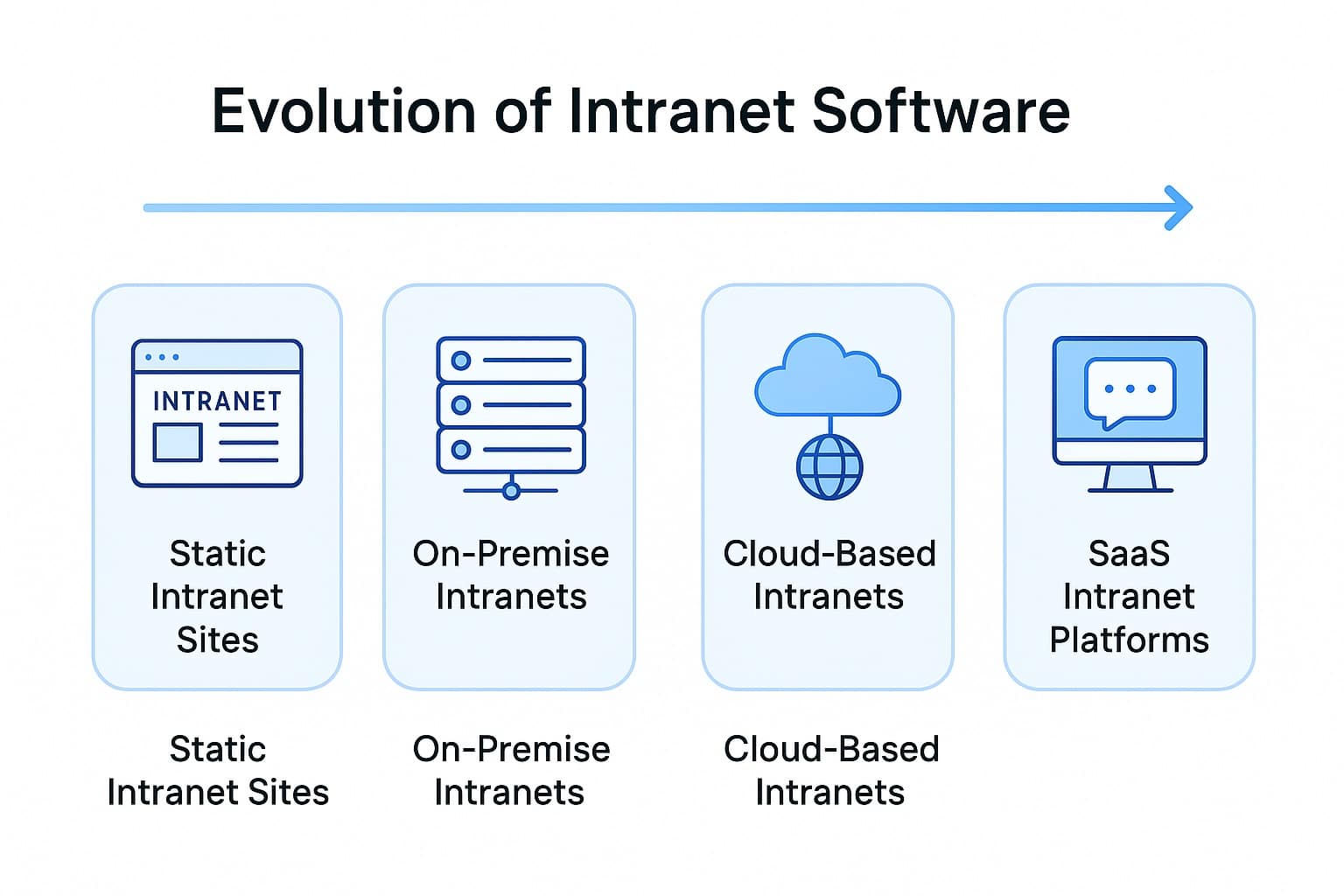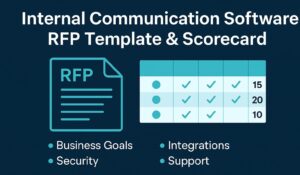A decade ago, an intranet was basically a digital filing cabinet. Today, intranet software is the backbone of the modern workplace. It’s where employees get real‑time updates, find critical documents instantly, collaborate with peers, and stay connected to culture—from any device. As we’ve worked with organizations across industries, we’ve seen how the right intranet software and intranet platforms eliminate communication gaps, reduce tool overload, and improve the employee experience at scale.
This guide covers everything we’ve learned about intranet software—what it is, how it works, the types available, the benefits, and what to look for when evaluating intranet solutions.
👉 Want a quick look at how a modern intranet works? Explore our employee intranet platform.
What Is Intranet Software?
Intranet software is a private digital environment where employees access company news, policies, documents, workflows, and tools. It keeps communication centralized and helps everyone—from frontline teams to corporate offices—stay aligned.
Over the years, this has evolved into what many now call a digital workplace intranet, a space that connects people, resources, and business systems.
A modern intranet includes:
- Communication hubs for news, updates, and leadership messages
- Knowledge systems with searchable SOPs, wikis, policies, and AI-powered search
- Social and engagement tools like recognition, comments, and surveys
- Workflows and integrations that tie into HRIS, Teams, Slack, and Google Workspace
- Mobile-ready interfaces for employees who aren’t behind desks
Intranet vs. Extranet vs. Internet
- Intranet: private to employees
- Extranet: private but accessible to approved partners or vendors
- Internet: publicly accessible to all
👉 Learn more: Intranet vs Extranet vs Internet. Also see how content flows with effective intranet communications.
Evolution of Modern Intranet Solutions
We’ve had a front-row seat to how intranet solutions have transformed over time:
- Static intranets were on‑premise and designed mainly to store files.
- Document-heavy intranets like SharePoint added structure and compliance but were difficult to scale.
- Modern intranet platforms became cloud-based, more visual, easier to use, and connected to everyday tools.
Today, modern intranets bring together communication, workflows, mobile access, and intelligence in one place.
📈 According to McKinsey, connected employees drive 20–25% more productivity, showing how important digital workplace intranets have become.

Types of Intranet Solutions
Here’s how we categorize the main types of intranet solutions:
| Type | Description | Pros | Cons | Best For | Key Features |
|---|---|---|---|---|---|
| Legacy Static | Basic CMS sites | Easy setup; low cost | One-way; minimal analytics | Small teams | File storage, static pages |
| Document-Centric | SharePoint/ECMs | Governance & version control | Complex; IT-heavy | Regulated industries | Libraries, workflows, permissions |
| Modern Dynamic | Cloud, AI, mobile-first | Personalized, social, integrated | Subscription cost | SMBs–Enterprises | AI search, social, mobile apps |
👉 Explore more about employee portals and intranet portals.
Benefits of Modern Intranet Platforms
From what we’ve seen, the value of modern intranet platforms goes far beyond sharing news.
1. Higher Productivity
Gartner reports employees spend 2.5 hours/day searching for information. Modern intranets reduce this dramatically through AI search and organized content.
2. Better Communication
Targeted messages, alerts, and feeds ensure employees receive the right updates at the right time. Edelman’s research even shows internal communication increases employee trust.
3. Culture and Engagement
Gallup found engaged teams are 21% more profitable. Social features—likes, comments, recognition—help us create a culture where contributions are seen.
4. Support for Frontline Teams
Deloitte reports 52% of frontline workers would leave due to poor workplace tech. Mobile-first intranets close this gap.
5. Governance at Scale
Role-based permissions, structured content, and analytics help organizations scale responsibly.
Core Features of Modern Intranet Applications
If you’re evaluating intranet solutions, here are the features we consistently find most critical:
- Employee portal for easy access to tools and resources
- Knowledge management with wikis, pages, and AI-powered search
- Targeted communications with campaigns, newsletters, and alerts
- Social intranet features like recognition and communities (social intranet platforms)
- Multilingual support for global teams (multilingual intranet software)
- AI integration with personalization and automation (AI-powered workplaces)
- Intranet search engine tools that return instant answers (intranet search engine)
- Integrations with systems employees already use (intranet apps)
- Security and governance controls (intranet security)
- Cloud infrastructure for global reliability (cloud intranet)
We’ve learned that the best intranets focus on usability, scalability, and engagement—because technology only works when people actually use it.
Top Intranet Platforms & Enterprise Intranet Software in 2025
Here are the best intranet platforms we recommend organizations evaluate in 2025. These span SMBs to global enterprises and represent the top solutions in the market.
| Platform | Best For | Key Features | Pricing* |
|---|---|---|---|
| HubEngage | All-in-one; SMBs to Enterprises; frontline teams | Multi-channel comms (push, SMS, email, Teams, Slack, WhatsApp); Recognition & gamification; Surveys & AI chatbot; Analytics & automation | Starting at $3/user/month |
| Microsoft SharePoint | Large enterprises, regulated industries | Document management, enterprise-grade governance, workflows | Included in M365 enterprise plans |
| LumApps | Enterprises using Google ecosystem | Social intranet + Google Workspace integration | Custom pricing |
| Staffbase | Regulated industries, global enterprises | Employee comms hub, branded mobile app, compliance controls | Quote-based enterprise pricing |
| Firstup | Enterprises with complex comms needs | Multi-channel messaging orchestration | Custom enterprise pricing |
| Simpplr | SMBs and midsize businesses | AI-powered intranet, intuitive UI, fast rollout | Per-user/month pricing |
| Happeo | Midmarket, hybrid organizations | Google Workspace-native, social features | Subscription-based |
| Beekeeper | Frontline and deskless industries | Mobile-first platform, workforce reach | Per-user/month |
| Blink | SMBs, retail & hospitality | Lightweight comms app, mobile adoption | Subscription-based |
| Unily | Multinationals, compliance-heavy orgs | Enterprise-scale, customizable, secure | Enterprise license |
| Workvivo | Enterprises focused on culture & engagement | Social feeds, recognition, integrations | Subscription-based |
| Interact | Organizations needing deep CMS + comms | Content publishing, governance, search | Quote-based |
| Axero | SMBs & midsize companies | Collaboration hub, knowledge base, forums | Tiered pricing |
| Jive | Enterprises needing social collaboration | Forums, communities, analytics | Custom pricing |
| ThoughtFarmer | Companies wanting social + intranet hybrid | Social features + structured intranet | Subscription |
| MyHub | SMBs on budget | Simple intranet builder, templates | Low-cost monthly plans |
| Bloomfire | Knowledge management & content sharing | Q&A, search, knowledge repository | Subscription |
We continuously evaluate these platforms based on usability, innovation, mobile support, and long-term scalability.
Why HubEngage Ranks Among the Best Intranets
When we designed HubEngage, we focused on real problems we saw across industries: too many tools, poor adoption, inconsistent communication, and no single place to engage employees.
That’s why our approach to intranet software brings together everything in one platform:
- A unified employee experience
- Multi-channel communication reach
- Easy-to-use mobile and desktop apps
- Analytics to guide decisions
- Scalability from small teams to global enterprises
This holistic approach is why many organizations consider HubEngage among the best intranets available.
Importance of Intranet Platforms in Today’s Workplace
As workplaces shift to hybrid, remote, and frontline models, intranet platforms have become mission‑critical to the digital workplace. We’ve seen firsthand how organizations rely on intranet software to create structure, reduce noise, and make communication predictable instead of reactive. When information is scattered across emails, chats, shared drives, and multiple apps, employees lose clarity, time, and trust. A centralized intranet platform solves that.
Modern intranet solutions act as the single source of truth—the place employees instinctively go when they need information or direction. Whether it’s a company-wide announcement, a new policy, safety procedures, shift updates, or HR resources, the intranet eliminates guessing and ensures everyone receives consistent, accurate information.
We’ve watched organizations use intranet platforms to:
- Reinforce culture and leadership visibility
- Reduce dependency on email by 40–60%
- Improve change management speed and adoption
- Keep frontline and deskless teams aligned with corporate updates
- Provide transparency around decisions, priorities, and business goals
A modern intranet solution ensures employees always know where to go for updates, policies, tools, and training—and more importantly, it helps them feel informed, included, and connected to the organization’s mission.
Employee Intranet Software: How It Helps Companies
From our experience, intranet software supports every industry differently:
- Healthcare: real-time updates improve patient care and safety
- Manufacturing: structured communication reduces safety incidents
- Retail & logistics: improved communication reduces turnover
- Corporate environments: better alignment across departments
In all cases, the intranet becomes the digital backbone of daily work.
Integration of Intranet Software with Other Tools
Modern intranet platforms integrate with everyday systems—Teams, Slack, Google Workspace, HRIS tools, LMS platforms, and industry‑specific software—to simplify and unify the entire digital workplace. We’ve seen how these integrations eliminate confusion, reduce time spent switching between apps, and create a seamless employee experience.
Where legacy intranets relied on manual uploads or scattered data sources, modern intranet software pulls everything together:
- Communication integrations: Employees can receive intranet updates inside Teams or Slack, keeping communication flowing where they already work.
- HRIS & payroll integrations: Profiles, org charts, job roles, and permissions stay in sync automatically.
- LMS integrations: Training modules, compliance courses, and certifications appear directly in the intranet instead of a separate system.
- Workflow systems: Integrations with ServiceNow, Jira, or ticketing systems allow employees to track tasks and submit requests without leaving the intranet.
- Identity systems: SSO and identity providers like Okta and Azure AD make login frictionless and secure.
When all of these tools speak to each other, the intranet becomes a true command center for work—not just a content hub. We’ve watched organizations save hundreds of hours by centralizing workflows and removing the need for employees to chase information across multiple platforms.
Social Intranet Platforms for Engagement
We’ve seen social intranets completely transform engagement inside organizations. When employees can post updates, celebrate wins, share ideas, and have conversations in a shared digital space, the intranet becomes much more than a communication tool—it becomes a community.
Modern social intranet features include:
- Interactive newsfeeds that behave like familiar social platforms
- Peer‑to‑peer recognition that boosts morale and visibility
- Employee groups and communities for teams, hobbies, and culture building
- Comments, reactions, and mentions to encourage open dialogue
- User‑generated content to increase participation
These features matter even more as younger generations enter the workforce. Gen Z—now one of the fastest‑growing segments—expects social‑style communication and interactive tools. In fact, 70% expect social-style tools at work, making social intranets essential for sustained engagement.
The most successful organizations we work with use social intranet features to create energy, strengthen culture, and give every employee a voice.
Best Intranet Websites for Inspiration
The best intranet websites don’t happen by accident—they’re intentionally designed to help employees find what they need quickly. We’ve studied hundreds of intranets, and the highest‑performing ones share several traits:
- Clean, uncluttered layouts that reduce cognitive load
- Dynamic content feeds that automatically surface the most relevant updates
- Personalized dashboards based on an employee’s role, location, and department
- Clear navigation structures with intuitive categories
- Search‑first experiences powered by AI and metadata
Where older intranets required teams to manually design and publish individual pages, modern intranet platforms automate layout and design choices so communication teams can focus on messaging—not page building.
According to Nielsen Norman Group, poor usability can cut productivity by 20–40%. We’ve seen this firsthand—when intranets are confusing or inconsistent, employees stop using them. But when design is intuitive and content is personalized, usage skyrockets.
These examples inspire stronger design decisions and remind us that an intranet isn’t just a content library—it’s part of the employee experience, every single day.
]👉 Browse examples: Best Intranet Websites
How to Choose the Right Intranet Solution
When we guide companies through intranet selection, we look at:
- Goals and outcomes – What problems are you solving, and how will success be measured? Are you trying to streamline communication, reduce turnover, centralize knowledge, or unify tools?
- Content structure and ownership – Who will own content, governance, and maintenance? A successful intranet solution needs clear roles and accountability.
- Employee experience and usability – The best intranet platforms succeed because employees actually want to use them. We encourage teams to evaluate navigation, search, and personalization closely.
- Integrations and ecosystem fit – Your intranet must work with tools your teams rely on—Teams, Slack, Google Workspace, HRIS, LMS, and operational systems. A modern intranet solution brings them together.
- Mobile accessibility – Frontline and deskless workers should have the same quality experience as office employees. Mobile-native interfaces are now non‑negotiable.
- Scalability and governance – As companies grow, intranet platforms must support multilingual content, permission structures, compliance needs, and analytics.
- AI and automation readiness – AI-powered search, auto‑translation, content suggestions, and workflow automation dramatically improve adoption and efficiency.
When we evaluate intranet software with clients, we always recommend running a pilot with a small group. Their feedback almost always reveals unexpected insights about what employees value most.
Future of Intranet Software (AI & Beyond)
Intranets are evolving into digital workplace assistants:
- Predictive search & instant answers
- Generative content authoring
- Signal-driven targeting across push, Teams, Slack, WhatsApp
- Unified analytics tied to business outcomes
- AI-driven personalization and automation for every employee role (AI-powered workplaces)
Conclusion
Over the years, we’ve seen intranet software evolve from simple information repositories into powerful, dynamic digital workplace hubs. Today, intranet platforms bring communication, knowledge, workflows, automation, and culture together in one unified experience. They reduce noise, close communication gaps, and help employees stay focused on what matters.
Whether you’re supporting global teams, frontline workers, hybrid staff, or fast‑growing operations, the right intranet solution becomes the foundation for productivity and engagement. It aligns people, connects tools, and strengthens culture.
As organizations continue to modernize, we believe the intranet will remain one of the most important systems in the digital workplace. And when built with the employee experience in mind, it becomes more than a tool—it becomes a central part of how people work, communicate, and thrive.
If you want to see how we approach intranet software and what a unified, modern intranet looks like in action, explore the HubEngage employee intranet platform.
👉 See the HubEngage employee intranet platform in action today.
FAQs on Intranet Software
What is intranet software?
Intranet software is a secure digital environment where employees access company news, documents, tools, and workflows. Modern intranet platforms also support collaboration, social engagement, mobile access, and AI-powered search—making them the hub of the digital workplace.
What features should intranet software include?
The strongest intranet platforms include:
- Collaboration spaces, news hubs, and document libraries
- AI search, automation, and personalized content targeting
- Multi-channel communication (push, SMS, email, Teams, Slack, WhatsApp)
- Mobile apps for frontline and deskless teams
- Role, location, and language-based personalization
- Integrations with HRIS, M365/Google Workspace, LMS, and ticketing systems
- SSO, security controls, and strong governance
What is the best intranet software in 2025?
There isn’t a single winner for every organization. The best intranet software depends on your size, workforce mix, and compliance needs. Many companies choose solutions like HubEngage for its engagement-first, all-in-one approach—combining communications, social features, recognitions, surveys, automation, and AI. The right choice starts with understanding your goals and evaluating how a modern employee intranet platform can consolidate tools and reduce costs.
Which intranet platforms are best for enterprises?
Enterprises often evaluate platforms like HubEngage, Microsoft SharePoint, Staffbase, Unily, LumApps, and Firstup. These intranet platforms offer global scale, advanced permissions, governance, analytics, and deep integrations with Microsoft 365, Google Workspace, and HRIS systems.
What’s the difference between company intranet software and corporate intranet software?
The terms are often used interchangeably. “Company intranet software” typically refers to solutions suited for organizations of all sizes, while “corporate intranet software” usually implies enterprise-level capabilities such as compliance workflows, advanced governance, and global content management. If you’re evaluating options, start with an understanding of modern intranet software and choose an employee intranet platform that can scale with your needs.
What are examples of intranet solutions?
Examples include company intranet software, social intranet platforms, employee portals, cloud intranets, and digital workplace intranets. Each supports different use cases, from communication and engagement to knowledge management and workflow automation.
How much does intranet software cost?
Pricing varies widely based on features, scale, and vendor. Here’s a general range:
| Company Size | Typical Pricing Range |
|---|---|
| SMBs | $3–$10 per user/month |
| Midmarket | $6–$12 per user/month |
| Enterprises | Custom pricing (per user/month) |
Enterprise-focused platforms may require annual contracts, while SMB solutions offer flexible month-to-month pricing. Many vendors—including HubEngage—offer demos or trials so teams can validate usability and adoption before committing.
What are the top intranet tools in 2025?
Leading intranet tools include HubEngage, Microsoft SharePoint, Staffbase, LumApps, Simpplr, and Workvivo. Each platform fits different needs, from SMB simplicity to enterprise-level governance. The right choice depends on your preferred workflows, integrations, and employee experience priorities.
What are intranet platforms used for?
Intranet platforms are used to centralize communication, streamline workflows, store and organize documents, and provide employees with a single place to access tools, updates, and resources. Companies rely on them to reduce silos, ensure consistent messaging, and improve collaboration across departments and locations.
How does intranet software improve internal communication?
Intranet software improves internal communication by offering targeted announcements, leadership messaging, real-time updates, and multi-channel reach. It ensures employees receive the right information at the right time through structured feeds, alerts, and notifications—reducing reliance on scattered emails or chat threads.
Can intranet software integrate with HR and project tools?
Yes. Modern intranet solutions integrate with HRIS, payroll systems, project management tools, collaboration suites, learning platforms, and ticketing systems. These integrations help employees access everything in one place, automate data flows, and reduce tool-switching throughout the day.
How do intranet platforms differ from employee portals?
An intranet platform is a full digital workplace hub for communication, knowledge, workflows, and culture. An employee portal is more narrowly focused on HR self-service tasks such as paychecks, benefits, time-off requests, or employee forms. Today, many modern intranets combine both experiences in one platform.
Is intranet software the same as a digital workplace intranet?
Not exactly. Traditional intranet software focused on static pages and document storage. A digital workplace intranet integrates communications, apps, workflows, automation, and AI into a single unified experience—supporting hybrid and frontline workers more effectively.
What are the common challenges in maintaining intranet software?
Common challenges include keeping content updated, ensuring employees can find information easily, maintaining governance standards, driving adoption, and integrating with existing tools. Without a clear ownership model and consistent content strategy, intranets can become outdated or underused.
How do companies measure the ROI of intranet software?
Organizations measure intranet ROI through metrics such as reduced email volume, higher engagement rates, improved search success, lower turnover, fewer support tickets, faster onboarding, and increased productivity. Many companies also track message reach, content completion, and reduced reliance on legacy tools.
How secure is modern intranet software?
Modern intranet software includes enterprise-grade security such as SSO, encryption, MFA, role-based permissions, audit logs, and compliance with frameworks like SOC 2, GDPR, or ISO standards. Cloud intranet platforms are continuously updated to meet evolving security threats.
How can intranet software be customized for different departments?
Intranet software supports department-specific pages, content targeting, workflows, and access rules. HR may manage onboarding and policies, IT handles service updates, Operations manages SOPs, and Communications manages company-wide messaging—all within a unified, permission-controlled environment.
Related internal links for deeper exploration:
• Intranet Communications: How Companies Connect in 2025
• Intranet vs Extranet vs Internet: Definitions, Differences & Examples
• Maximize Your Company Intranet Software Rollout With These 7 Tips
• Employee Portal: The Complete Guide to Staff & ESS Portals, Software & Apps
• Intranet Portal: The Digital Front Door to Your Organization
• Multilingual Intranet Software with Auto-Translation for a Global and Diverse Workforce
• AI Powered Workplaces with Smarter Solutions for Businesses
• Social Intranet: The Future-Proof Platform to Engage & Retain Your Workforce
• Intranet Search Engine: AI-Powered Internal Search for Companies
• Best Intranet Websites & Examples: For Enhanced Internal Communication
• Intranet Apps: The Best Mobile Intranet Apps for 2025
• Choosing the Right Intranet Provider: Complete Guide for 2025
• Cloud Intranet: Definition, Benefits, Comparisons & Best Software
• Intranet Security: How to Build a Secure Intranet Platform in 2025














